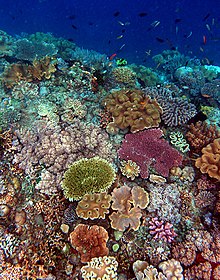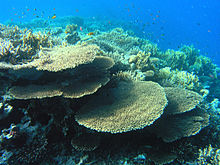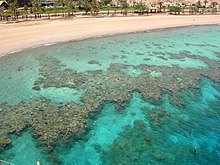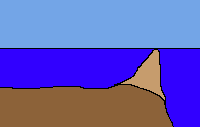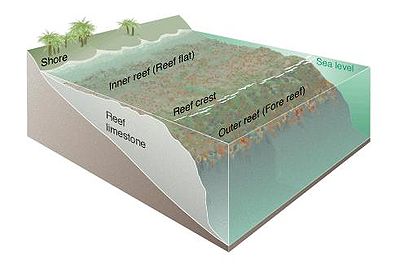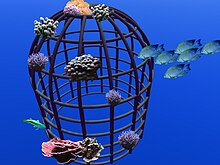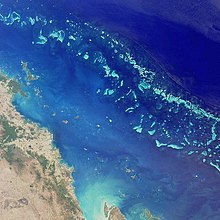Coral reef
A coral reef (also known as the “rainforest of the seas” because of the very large biodiversity ) is a reef structure in the sea formed by hermatypical (reef-building) cnidarians , which is large enough to exert a significant physical and ecological influence on its environment. They are the largest structures on earth created by living beings. The total area of today's coral reefs is 600,000 km², in the Maldives the reefs rise up to 2200 meters above the sea floor.
Origin and Effect
Coral reefs are mainly built up from corals from the group of hard corals (Scleractinia), in addition, the fire corals ( Millepora ) and, in the tropical Indo-Pacific , the blue coral ( Heliopora coerulea ) contribute to reef formation. Hard corals colonize both the deep sea and the shallow water up to the surface of the water. Over the course of many centuries, they build the reef structure from their limestone skeletons.
A coral island is created by long-term changes in the water level. Since the coral reef can grow to the surface of the water, an island or series of islands, often in the form of an atoll , is formed when the sea level is later lowered or the bottom rises .
Coral reefs are complex marine ecosystems . They are the biotope (habitat) for a biocenosis (community) of plants and animals, for example worms , molluscs , sponges , echinoderms and crustaceans . A large importance coral reefs as "nursery" for pelagic living fish .
Types
According to their geographic distribution, coral reefs can be divided into two types: tropical coral reefs and deep water reefs.
Tropical coral reefs
Reef-forming corals from tropical coral reefs can only survive at water temperatures that rarely fall below 20 ° C. For these reasons, the formation is limited to an area between approximately 30 ° north and 30 ° south latitude . In the Atlantic, the northernmost coral reefs are on the coast of Bermuda (32 ° 30 ' north latitude ), the southernmost a little north of Rio de Janeiro (23 ° S). Two species of hard coral that normally form reefs can still be found at Cape Hatteras (34 ° N) on the east coast of the United States , but they no longer form reefs there. The situation in the Pacific in Tokyo Bay (38 ° N) is similar . Tropical coral reefs only occur here from the Ryūkyū Islands at 30 ° N. The southernmost branch of the Great Barrier Reef is north of Brisbane in Moreton Bay (27 ° 30 'S), another very southerly reef in the Pacific near Rapa Iti, at the same altitude. On Lord Howe Island , a warm ocean current enables coral reefs to form at 31 ° 30 'S. In the Red Sea, coral reefs can be found as far as its northern extension, the Gulf of Aqaba (29 ° 30' N). The southernmost coral reef in the world is located in the Indian Ocean at the Houtman-Abrolhos Archipelago on the west coast of Australia (29 ° S). On the west coast of the Indian Ocean, coral reefs extend to Inhaca Island in Maputo Bay (26 ° S, Mozambique).
Since the vast majority of hard corals live in symbiosis with zooxanthellae , they are dependent on the sunshine, which rapidly decreases with increasing water depth. The total area of all coral reefs is about 600,000 km² . An average of 640 million tons of reef limestone is deposited annually .
A distinction is made between two main categories of tropical coral reefs:
- Littoral (close to the coast) reefs are found in the shallow water zones of the continental shelves . Freshwater discharge makes these reefs richer in nutrients than neritide reefs, which means that such reefs are more often dominated by soft corals and algae .
- Neritide reefs are found far from the continents when volcanic activity creates islands above the water surface. Neritide reefs are mainly found in the tropical Pacific ( Hawaii , Tahiti ). Here, due to the lower nutrient content than in littoral reefs, there is a higher biodiversity, especially with hard corals.
Deep water reefs
Many coral species can also live in cooler and cold water at temperatures well below 20 ° C and sometimes below the euphotic zone at depths of many hundreds of meters in complete darkness. Unlike their tropical relatives not living in endosymbiosis with zooxanthellae and not use sunlight as a primary energy source, but eat as filter feeders of zooplankton . The majority of the coral species in cool and cold water are solitary corals from the families of the Caryophylliidae and Dendrophylliidae , which grow very slowly, remain small and therefore do not form reefs.
Fewer than 20 of the 1000 known species are reef builders. One of the exceptions is the genus Lophelia , which is colony-forming and, together with Madrepora oculata , forms extensive, hedge-like coral reefs. The largest Lophelia reefs reach a height of 45 meters and a length of two kilometers. They grow very slowly compared to tropical coral reefs. The average growth is 7.5 mm / year, with a maximum of 20 to 25 mm / year. So very large reefs must be several thousand years old. Cold-water coral reefs occur in the upper areas of continental margins , on deep-sea mountains , on oceanic banks and plateaus , such as the Rockall Plateau, the Chatham Ridge or the Porcupine and Hatton Banks . A belt of these coral reefs extends along the European continental margin from the Iberian Peninsula to the North Cape . Deep water reefs are typically found in water depths of 200 to 600 meters. In Norwegian fjords they are found from a depth of 52 m. At least 37 hard coral species are known from the Mediterranean Sea, some of which can also form reefs.
These cold water reefs are also threatened in their existence by human influences. In addition to the acidification and pollution of the oceans, modern fishing methods pose the greatest threat to this habitat. A single bottom trawl can destroy a reef that has grown for several thousand years in just a few minutes.
Types of tropical coral reefs
Coral reefs differ fundamentally in their shape and origin.
Fringing reefs
A fringing reef extends along the coast of the mainland or an island. It is the most common type of reef and almost the only one in the Red Sea. Fringing reefs extend along coastlines and can be many kilometers long. Their width is usually less than 100 meters, but can also be several hundred meters. Fringing reefs initially arise directly on the shore at the level of the low water limit and, as they grow, expand more and more seaward. Their final width depends on where the sea floor drops steeply. The surface of the fringing reef always remains at the same height just below the waterline. With older fringing reefs, the outer areas of which have pushed themselves far out into the sea, the inner part is deepened by erosion and finally forms a lagoon . Fringing reef lagoons can be over 100 meters wide and a few meters deep. Like the fringing reef, they extend parallel to the coast.
Barrier reefs
Barrier reefs are similar to the late stages of a lagoon fringing reef. They differ from these mainly in their size and their origin. Your lagoon can be several kilometers wide and 30 to 70 meters deep. Above all, the advanced outer reef edge is not a reef that used to be on the shore and then expanded further and further towards the open sea as it grew, but it has been there from the beginning. Similar to an atoll, a lowering of the sea floor or a rise in sea level is a prerequisite for reef formation. Since a geological process is required for reef formation and reef formation takes considerably longer than that of the fringing reef, barrier reefs are much rarer. The best-known barrier reef is the Australian Great Barrier Reef . Other large barrier reefs are the Belize Barrier Reef and the New Caledonian Barrier Reef . Barrier reefs are also found on the coasts of Providencia , Mayotte , the Gambier Islands , the southeast coast of Kalimantan , parts of the coast of Sulawesi , southeast New Guinea, and the southern coast of the Louisiade Archipelago .
Platform reefs
While the reef types presented so far always arise on the coasts of islands or continents, platform reefs can form on the continental shelf as well as in the open ocean, wherever the sea floor rises so far towards the water level that the growth of zooxanthale, reef-forming corals is possible is. In the southern Great Barrier Reef there are several platform reefs, the Swain and Capricorn groups on the continental shelf, about 100 to 200 km from the coast. Some platform reefs in the northern Mascarene Islands are even several thousand kilometers from the mainland. In contrast to fringing and barrier reefs, which only expand seaward, platform reefs grow in all directions. They can reach quite different sizes, from a few hundred meters to many kilometers. Usually their shape is oval to very elongated. Parts of the reefs can reach to the surface, forming sandbanks and small islands around which their own fringing reefs can form. There may be a lagoon in the middle of a platform reef . Platform reefs can also be found within atolls. Here they are called spotted reefs and only reach a diameter of a few dozen meters. Platform reefs rise on an elongated structure, e.g. B. a submerged, former barrier reef, they can be arranged in a row. This is e.g. B. the case on the east coast of the Red Sea near Jeddah . The inner part of very old platform reefs can be so badly eroded that they form a pseudo atoll. They can only be distinguished from real atolls by precise examinations and possibly drilling. Some platform reefs in the Laccadives are U-shaped due to the wind and water currents.
Atolls
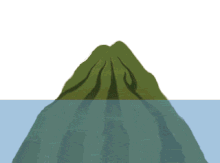
Atolls usually arise from fringing reefs around volcanic islands. Over time, the island is eroded away and sinks below sea level . A sinking of the sea floor or a rise in the sea level also leads to the formation of atolls. What remains is a ring of reefs that enclose a lagoon. The Maldives consist of 26 such atolls.
Zoning
Each reef can be divided into different zones in which different plants and animals live due to the prevailing conditions. These zones are differently pronounced for the various reef types, and the structure can also vary within one reef type. The typical structure of a fringing reef is explained below.
- The beach zone connects directly to the mainland. At low tide it falls dry twice for several hours during the day. The beach zone is mainly inhabited by crabs and snails . Algae , small clams and hermit crabs can be found below the water level at low tide .
- The reef roof , the horizontal part of the reef, joins towards the sea .
- In the inner areas, brown and blue algae dominate , further seaward followed by red algae . Only a few animal species live in this algae zone. The most common are some species of sea urchin . Even brittle stars and crabs can be encountered. Few fish live in this zone, mainly small gobies and slime fish . In the outer regions of the algae grow zone various soft corals , are also occasionally stony corals to be found.
- There is a high biodiversity in the transition zone. The water here is deeper and clearer, the water movement stronger than further inland. Here you can find larger colonies of stony corals, which can form so-called microatolls. These areas can occasionally still fall dry.
- The outer area between the inner reef slope and the outer reef edge never falls dry. It is on average 10 meters wide and has a water depth of 40 cm to one meter. A strong wave movement prevents sand and other loose material from depositing. Tunnels and channels with strong currents are formed. Hard and soft corals dominate here, algae, on the other hand, are rarely found. The main fish found are damselfish , wrasse and surgeon fish .
- The outer reef edge is exposed to strong surf . The hard corals dominate, among them several Acropora species. Sea anemones grow in the strong current . At the reef edge and in the upper part of the reef slope there are many school-forming fish that hunt plankton from the protection of the coral sticks. Filter feeders such as sponges, sea squirts and hard corals of the Tubastraea genus thrive in underwater caves . Many fish also use such caves for their protection, for example soldier fish .
- In the fore reef , which represents the transition from the reef slope to the open sea, there are reef pillars separated from each other by sandy areas that are densely overgrown with corals. In the deepening water in front of the reef pillars, there are many species of hard and soft corals, the number of which decreases with increasing water depth. The fore reef is the habitat of many fish, such as butterfly fish and angelfish . Even predators such as groupers and moray eels have their territory here.
Artificial coral reef
For several years attempts have been made to create artificial coral reefs . Based on the observation that large objects sunken in the sea, such as ships and airplanes, were settled within a few years, artificial structures began to be specifically installed in the sea. There have been major failures, such as the Osborne Reef made from millions of old car tires, and successes. So were z. B. reef balls are used and steel constructions based on Biorock technology are placed under weak direct current in order to be able to deposit minerals in a short time that coral polyps like to colonize. In marine aquariums , too , one deals with the artificial replication of coral reefs.
meaning
Worldwide, the livelihood of around half a billion people depends at least in part on the existence of coral reefs. It is also assumed that around 30 million people, mostly residents of atolls, are completely dependent on such reefs. In addition, corals protect beaches from erosion and storm damage. The reefs are valued by tourists for their beauty. Coral reefs are also home to a large number of marine life and are of great importance for their existence.
"International Year of the Reef"
In order to underline the ecological importance of the reefs worldwide and to point out their multiple existential threats, after 1997, 2008, the year 2018 was proclaimed for the third time as the "International Year of the Reef".
Future and danger
The number of coral reefs is falling sharply; a fifth of all reefs have already disappeared. The reasons for this are dynamite fishing and cyanide fishing , overfishing in general, industrial pollution, construction activities and run-down ships. According to oceanologists, around 20 percent of coral reefs worldwide were destroyed in April 2007, and another 50 percent were in serious danger. In the following years several severe coral bleaching occurred worldwide; In 2016, around 90% of the reefs in the Great Barrier Reef bleached at least partially during the heaviest bleaching ever documented to date. It is true that bleaching is not synonymous with automatic death of all corals. Due to the ever shorter succession of ever stronger bleaching, the corals now no longer have time to recover from previous bleaching, so that the future of coral reefs is very questionable.
As early as the mid-1990s, in a survey, coral reef experts saw sediment inputs and eutrophication due to agriculture and, in some cases, forestry and unsustainable fishing as the most important threat factors. Global warming and the associated acidification of the oceans as a result of the rising carbon dioxide concentration in the earth's atmosphere due to human influence have the greatest negative effect .
In order to be able to preserve a small part of the corals, drastic climate protection measures are necessary; the political goal of limiting the rise in greenhouse gases to 2 ° Celsius does not protect the coral reefs: coral bleaching can start at 320 ppm CO 2 in the atmosphere. Acidification of sea water and other stressors had degraded 19 percent of the world's coral reefs by 2008 and another 35 percent were seriously threatened at that time, according to the Wilkinson report.
Due to rising water temperatures, coral bleaching is common worldwide; a further increase is expected. In order to preserve more than 10 percent of all coral reefs worldwide, global warming would have to be limited to less than 1.5 degrees of warming compared to pre-industrial times. The IPCC's special report 1.5 ° C global warming found that with two degrees global warming almost all coral reefs would be lost.
geology
The coral reefs formed in earlier geological ages are now known as bio-thermal baths or bio-currents . The Dolomites and the Hohe Dachstein and other mountains of the Northern Limestone Alps consist primarily of coral limestone and are fossil coral reefs that were raised in the course of the Alpid orogeny . At Hohen Göll in the Berchtesgaden Alps you can still distinguish between the zones of a reef, including a lagoon.
The first reefs created by living beings in the Precambrian , the stromatolites , were not created by cnidarians, but were created by capturing and binding sediment particles as a result of the growth of microorganisms , especially cyanobacteria . In the Lower Cambrian , small reefs were formed along with stromatolites by the archaeocyathids , who were perhaps a specialized group of sponges. They reached lengths of up to 30 meters and a width of up to three meters.
From the Ordovician to the Permian , the Tabulata and the Rugosa were the first reef formers among the flower animals. From then on one can speak of coral reefs. In the Silurian and Devonian , reefs were not only built up by corals, but also by living things called stromatopores , which may be related to sponges . With the mass extinction on the Permian Triassic border , to which the Rugosa and Tabulata fell victim, the reef formation came to a standstill. The first hard corals appeared from the Middle Triassic and increased in size over the course of the Mesozoic Era. In the upper Mesozoic belonging to the mussels are rudists other important reef builders. They are dying out at the Cretaceous-Tertiary border . Since then the hard corals have been the most important reef builders.
Examples
- Great Barrier Reef , off the coast of the Australian state of Queensland
- Belize Barrier Reef , off Belize
- New Caledonian Barrier Reef , near New Caledonia ,
- Coral triangle , it includes the Philippines , East Timor , parts of Indonesia , New Guinea and the Solomon Islands
See also
swell
Web links
- Riffe.de - website of the reef group around Reinhold Leinfelder with numerous internet links
- Reefs - a fascinating subject for school lessons . Profile volume 13 by R. Leinfelder, U. Kull, F. Brümmer (eds.) 2nd edition. 2002. (E-Text as PDF file, various download versions)
- Reinhold Leinfelder: Coral reefs - centers of biodiversity and evolution. In: W. Hansch (ed.): Catastrophes in the history of the earth. Turning times of life. (= Museo. 19). Heilbronn 2003, pp. 180-199.
- palaeo.de/tv - Talks and Presentations on Reefs Link Directory (English / German)
- Landsat images of coral reefs on earth
literature
- Helmut Schumacher: Coral reefs . BLV Verlagsgesellschaft, Munich 1988, ISBN 3-405-13614-8 .
- Paddy Ryan (photo), Peter Atkinson ( photo ), Veronika Straaß ( transl .): Snorkel guide coral reef. Identification book for the coral reefs in the Red Sea, Indian Ocean, Pacific . (How to snorkel properly and what to see). BLV Verlag, Munich 1995, ISBN 978-3-405-14855-3 .
- Yossi Loya, Ramy Klein: The world of corals . Jahr Verlag, Hamburg 1998, ISBN 3-86132-226-9 .
- Ulrich Sommer : Biological Oceanography. Springer, 1998, ISBN 3-540-63512-2 .
- Storch, Welsch, Wink: Evolutionary Biology. Springer, 2001, ISBN 3-540-41880-6 .
- James Bowen: The Coral Reef Era: From Discovery to Decline. A history of scientific investigation from 1600 to the Anthropocene Epoch. Springer, 2015, ISBN 978-3-319-07478-8 .
- Mark D. Spalding, Corinna Ravilious, Edmund P. Green: World Coral Reef Atlas, Cambridge 2001, ISBN 3-7688-1587-0 ( online )
Individual evidence
- ↑ a b "Rainforests of the Seas": A heart for reefs . ( rnz.de [accessed on January 6, 2018]).
- ↑ Sommer (1998), p. 261.
- ↑ Schumacher (1988), p. 22.
- ^ A b c André Freiwald, Lydia Beuck: Are cold water corals endangered by climate change? In: José L. Lozán, Hartmut Graßl, Ludwig Karbe, Karsten Reise (eds.): Warning signal climate: The seas - changes & risks . 2011 ( uni-hamburg.de ).
- ↑ Schumacher (1988), p. 18.
- ↑ KommKonzept Michael Charlier: Expedition discovers new coral deposits in the Mediterranean. Retrieved February 20, 2017 .
- ^ J Murray Roberts, Stephen D Cairns: Cold-water corals in a changing ocean . In: Current Opinion in Environmental Sustainability . April 2014, doi : 10.1016 / j.cosust.2014.01.004 .
- ↑ Stefan Rahmstorf , Katherine Richardson : How threatened are the oceans? , in: Klaus Wiegandt (Ed.): Courage for Sustainability. 12 ways into the future . Frankfurt am Main 2016, 113–146, p. 127.
- ↑ International Year of the Reef (IYOR) 2018. Retrieved January 6, 2018 .
- ↑ Friday, Dirty, Overfished Seas - Oceanologists Alert. April 13, 2007.
- ↑ Stefan Rahmstorf , Katherine Richardson : How threatened are the oceans? , in: Klaus Wiegandt (Ed.): Courage for Sustainability. 12 ways into the future . Frankfurt am Main 2016, 113–146, p. 126f.
- ↑ Helmut Schumacher, Götz-Bodo Reinicke: Coral reefs - consequences of warming and acidification . In: Warning signal climate: The seas. Changes & Risks . Scientific evaluations, Hamburg 2011, p. 214 .
- ^ C. Wilkinson: Status of coral reefs of the world. Global coral reef monitoring network and reef and rainforest research center . Townsville 2008, p. 298pp .
- ↑ K. Frieler, M. Meinshausen, A. Golly, M. Mengel, K. Lebek, SD Donner, O. Hoegh-Guldberg: Limiting global warming to 2 C is unlikely to save most coral reefs . In: Nature Climate Change . tape 3 , no. 2 , September 16, 2012, p. 165 , doi : 10.1038 / nclimate1674 .
- ↑ IPCC report: Even two degrees would be fatal. In: www.scinexx.de. October 8, 2018, accessed July 20, 2019 .
- ↑ Stefan Rahmstorf: Mankind is losing control over the state of the earth. In: Spiegel ONLINE. August 31, 2019, accessed September 7, 2019 .
- ↑ Schumacher (1988), p. 9.
- ↑ Storch, Welsch, Wink (2001), pp. 73-75.
- ↑ coraltrianglecenter.org
